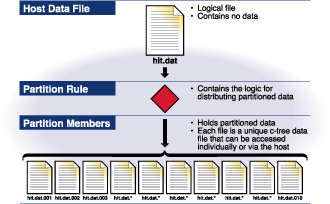FairCom DB supports a unique feature known as Partitioned Files. A partitioned file logically appears to be one file (or more accurately one data file and its associated index files), but is actually a set of files whose contents are partitioned by the value of the partition key. Both the data files and index files are partitioned. This permits data with a defined range of values for the partition key to be rapidly purged or archived (instead of having to delete record-by-record each record within this range).
A partitioned file is comprised of a host data file and its associated indexes combined with a rule. The rule determines how to map the partition key value (e.g., a date, or invoice number, or some other characteristic) into a particular partition member of the host. The host file does not contain any actual data, but serves as a logical file that appears to contain all the data.

A partition member file has the same definition as the host, but only holds data whose partition key maps to the member. For example, customer orders may be partitioned by calendar quarter. All orders booked in the same quarter are stored in the same member. A member is comprised of a standard FairCom DB data file and its associated indexes.
To add data to the partitioned file, simply call an add routine for the host. The code will add the record in the proper partition member, creating the partition member if necessary. Rewriting a data record may move the record between partitions if the partition key entry for the record is changed. Under transaction control, such a delete/add record operation is done atomically.
Searching the partitioned file in key order is fairly straightforward and efficient if the key is the partition key (the key used to determine which partition should contain the record). Searches on other, non-partition, keys are less efficient than normal because the record may exist in any of the partition members. The more active partition members there are in the logical file, the less efficient the non-partition key search will be.
It is possible to manage the partition members so that archiving or purging partitions is very quick and efficient.
Use partitioned files when the ability to easily purge or archive individual member files is desired. For example, partitioned files can be used to store records by date, so that all records in a given month are stored in one partition. Then, when the month’s activity is complete, the partition can be taken offline and archived or purged.